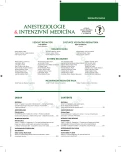Comparison of heparin and citrate anticoagulation during continuous veno-venous haemodialysis (CVVHD) in critically ill children – prospective, crossover study
Authors:
T. Zaoral 1; M. Hladík 1; J. Zapletalová 2
Authors‘ workplace:
Dětská klinika, Oddělení dětské intenzivní resuscitační péče, Lékařská fakulta OU, Fakultní nemocnice Ostrava
1; Ústav lékařské biofyziky, Lékařská fakulta, Fakultní nemocnice Olomouc
2
Published in:
Anest. intenziv. Med., 26, 2015, č. 5, s. 270-278
Category:
Intensive Care Medicine - Original Paper
Overview
Objective:
In continuous renal replacement therapy, heparin anticoagulation has been largely replaced with citrate anticoagulation to limit the risk of bleeding. In this prospective crossover trial, we compared the heparin and citrate effect on the circuit lifetimes during continuous veno-venous haemodialysis (CVVHD) in children.
Design:
Prospective, crossover trial.
Setting:
Paediatric intensive care unit, Department of Paediatrics, University Hospital.
Materials and methods:
From 2009 to 2014, 63 eligible children (age 89.24 ± 62.9 months, weight 30.37 ± 20.62 kg) received at least 24 hours of CVVHD. Each child received four CVVHD circuits with anticoagulants in the following order: heparin, citrate, heparin, citrate. Circuit life ended when the trans-membrane pressure was ≥ 250 mmHg for > 60 min.
Results:
The total mean circuit lifetime was 39.75 ± 10.73 h. Citrate had a significantly longer median circuit lifetime (41.0 h, CI: 37.6–44.4) than heparin (36.0 h, CI: 35.4–36.6; p < 0.0001). Mortality was 33.33%. Circuit lifetime was significantly correlated to patient age (r = 0.606), weight (r = 0.763), and blood flow rate (r = 0.697). Metabolic and electrolyte imbalances were readily resolved.
Conclusion:
We showed that citrate provided significantly longer circuit lifetimes than heparin for CVVHD in children. Citrate was found to be feasible and safe in children and infants in our study.
Keywords:
continuous venovenous hemodialysis – heparin – citrate – children
Sources
1. Monchi, M., Berghmans, D., Ledoux, D. et al. Citrate vs. heparin for anticoagulation in continuous venovenous hemofiltration: a prospective randomized study. Intensive Care Med., 2004, 30, p. 260–265.
2. Betjes, M. G., van Oosterom, D., van Agteren, M., van de W. J.Regional citrate versus heparin anticoagulation during venovenous hemofiltration in patiens at low risk for bleeding: simile hemofilter survival but significantly less bleeding. Journal of Nephrology, 2007, 20,; p. 602–608.
3. Kutsogiannis, D., Gibney, R., Stollery, D., Gao, J. Regional citrate versus systemic heparin anticoagulation for continuous renal replacement in critically ill patients. Kidney International, 2005, 67, 6, p. 2361–2367.
4. Wu, M. Y., Hsu, Y. H., Bai, CH., Lin, Y. F. et al. Regional citrate versus heparin anticoagulation for continuous renal replacement therapy: a meta-analysis of randomized controlled trials. American Journal of Kidney Disease, 2012, 59, 6, p. 810–818.
5. Brophy, P., Somers, M., Baum, M., Symons, J. M., McAfee, N.Multi-centre evaluation of anticoagulation in patiens receiving continuous renal replacement therapy (CRRT). Nephrology Dialysis Transplantation, 2005, 20, p. 1416–1421.
6. Soltysiak, J., Warzywoda, A., Kociński, B. et al. Citrate anticoagulation for continuous renal replacement. Pediatric Nephrology, 2014, 29, p. 469–475.
7. Fernández, S., Santiago, M., López-Herce, J., García, M., Del Castillo, J. et al. Citrate anticoagulation for CRRT in children: comparison with heparin. Biomed. Reearch International., Epub 2014, Aug 3, p. 1–7.
8. Akcan-Arikan, A1., Zappitelli, M., Loftis, L. et al. Modified RIFLE criteria in critically ill children with acute kidney injury. Kidney International, 2007, 71, 10, p. 1028–1035.
9. Akcan-Arikan, A1., Zappitelli, M., Goldstein, S. L. et al. Fluid overload is associated with impaired oxygenation and morbidity in critically ill children. Pediatr. Crit. Care Med., 2012, 13, p. 253–258.
10. Goldstein, B., Giroir, B., Randolph, A. Members of the International Consensus Conference Panel (2005) International pediatric sepsis consensus conference: definitions for sepsis and organ dysfunction in pediatrics. Pediatr. Crit. Care Med., 2005, 6, p. 2–8.
11. Stefanidis, I., Hägel, J. et al. Hemostatic alterations during continuous venovenous hemofiltration in acute renal failure. Clinical Nephrology, 1996, 46, 3, p. 199–205.
12. Chadha, V., Garg, U.,Warady, B., Alon, U. Citrate clearance in children receiving continuous venovenous renal replacement therapy. Pediatric Nephrology, 2002, 17, p. 819–824.
13. Gabutti, L., Marone, C. Citrate anticoagulation in continuous venovenous hemodiafiltration: a metabolic challenge. Intensive Care Medicine, 2002, 28, p. 1419–1425.
14. Sohn, Y. B., Paik, K. H., Cho, H. Y., Kim, S. J., Park, S. W. et al.Continuous renal replacement therapy in neonates weighting less than 3kg. Korean Journal of Pediatrics, 2012, 55, 8, p. 286–292.
15. Goldstein, S. L. Advances in pediatric renal replacement therapy for acute kidney injury. Seminars in Dialysis, 2011, 24, p. 187–191.
16. Mehta, R. L., McDonald, B. R. et al. Regional citrate anticoagulation for continuous arteriovenous hemodialysis in critically ill patients. Kidney International, 1990, 38, p. 976–981.
17. Moghal, N. E., Brocklebank, J. T., Meadow, S. R. A review of acute renal failure in children: incidence, etiology and outcome. Clinical Nephrology, 1998, 49, p. 91–95.
18. Bailey, D., Phan, V., Litalien, C. et al. Risk factors of acute renal failure in critically ill children: A prospective descriptive epidemiological study. Pediatr. Crit. Care Med., 2007, 8, p. 29–35.
19. Pedersen, O., Jepsen, S. B., Toft, P. Continuous renal replacement therapy for critically ill infants and children. Danish Medical Journal, 2012, 59, 2, A4385.
20. Kramer, L., Bauer, E., Joukhadar, C. et al. Citrate pharmacokinetics and metabolism in cirrhotic and noncirrhotic critically ill patients. Crit. Care Med., 2003, 31, p. 2450–2455.
Labels
Anaesthesiology, Resuscitation and Inten Intensive Care MedicineArticle was published in
Anaesthesiology and Intensive Care Medicine

2015 Issue 5
Most read in this issue
- Comparison of heparin and citrate anticoagulation during continuous veno-venous haemodialysis (CVVHD) in critically ill children – prospective, crossover study
- Patophysiology and diagnostics of anaphylactic syndrome of pregnancy
- Echocardiography for preload and fluid responsiveness assessment
- Practice advisory on anesthetic care for magnetic resonance imaging
